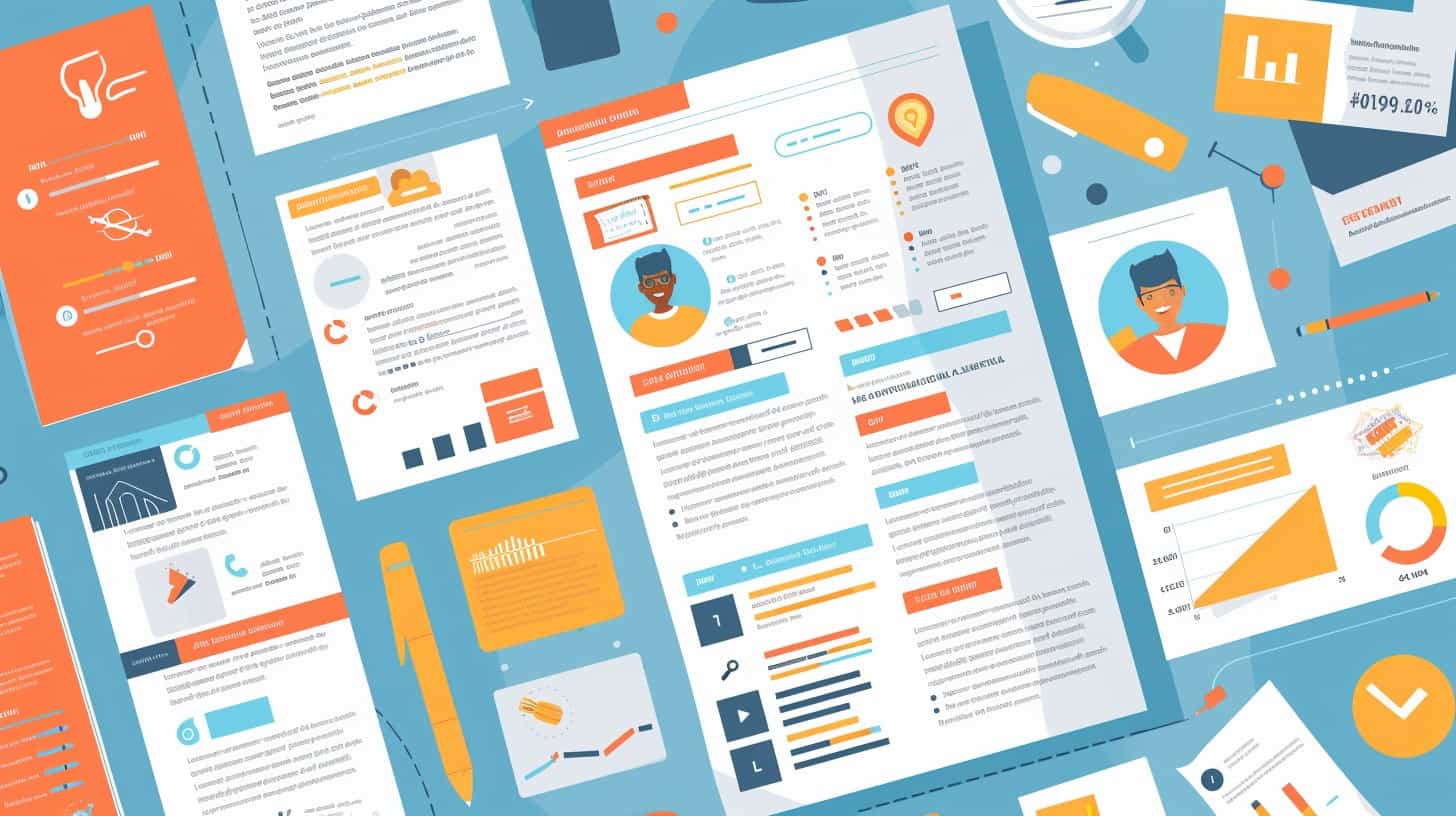Crafting a tech resume feels like trying to solve a puzzle with missing pieces. Here’s the shocker: many of us are not showing our best bits on paper. This guide will turn that around, helping you shine in front of employers.
We’re diving into everything – from layouts that grab attention to skills that pop off the page… Let’s make recruiters sit up and take notice!
Key Takeaways
Making your tech resume stand out means using a clear layout, listing your latest projects and skills, and adding numbers to show off your achievements. This helps recruiters see what you can do.
Adding personal touches like an online portfolio or links to professional profiles shows more of who you are and what you’ve done outside of just a paper resume.
Choosing the right format for your experience and focusing on recent training or certifications can make a big difference. It tells employers how up-to-date you are with technology.
Sharing details from real work experiences, like solving problems or leading projects, proves that you have the skills needed for the job.
Keeping everything current, from contact information to the education section, ensures that hiring managers get all they need to consider you for their open positions.
Table of Contents
The Importance of a Tech Resume

A tech resume is your golden ticket in the job hunt game. Let’s face it, with so many wizards and warriors trying to land those overemployed jobs, standing out is key. This isn’t just a piece of paper or another PDF file in the pile.
It’s you on a page—your skills, your achievements, all screaming “Pick me!” Recruiters spend just seconds scanning each one. They’re looking for that spark—whether it’s in cybersecurity smarts or cloud computing prowess.
Now think AI-powered tools, software like LinkedIn and applicant tracking systems—they’re all part of this process too. Your resume needs to impress not only human eyes but these digital gatekeepers as well.
So we dive into expertise next—showing off what you know and how well you wield those tech powers.
Key Elements of a Successful Tech Resume

In a tech resume, it’s all about showing off your computer chops and your wins in a way that pops. Think personal blurb, your skills in things like coding or cloud services, and big moments you’re proud of.
You also want to sprinkle in bits about where you’ve been on the online scene – think GitHub or LinkedIn. And hey, if you’re wondering how to use ChatGPT to write a resume, imagine it as having a savvy friend give your words an extra edge.
Personal Summary
Your personal summary is like opening a window into your tech world. It tells the hiring team why you’re eyeing that developer or data analyst spot. Think of it as your professional selfie – quick, clear, and showing off your best side.
This section zooms in on what makes you tick as a programmer or digital marketer, highlighting your love for crafting code or strategizing social media campaigns.
You’re not just listing skills but weaving them into a narrative. Describe how your journey through coding marathons, cloud computing battles, and creating bug-free software sculpted you into the tech wizard you are today.
Use this space to show how past adventures with Python scripts, AI innovations, or managing remote teams fuel your drive for their open position. Remember, it’s about connecting dots – from where you’ve been technologically to where you aim to venture with their company by your side.
Expertise
In your tech resume, showing off your expertise is like a superhero flaunting their powers. List programming languages you speak fluently—Python, JavaScript, or maybe SQL. Don’t forget to highlight systems you’ve tamed like Linux or Windows and tools that are more like sidekicks in your adventures—think version control with Git or project tracking with Jira.
This section is where you tell tales of vanquishing bugs and building fantastic digital worlds.
Next up, nail down those accomplishments. It’s not just about what you know but what you’ve done with it. Imagine saying, “I boosted website speed by 50%,” rather than a vague “improved website performance.” Be specific; numbers talk louder than words! Now let’s dive into showcasing those victories….
Accomplishments
Your resume needs to show off what you’ve achieved. Think projects where you used AI to solve problems, or successful software you helped create. Make sure these wins are easy for recruiters to spot.
Use numbers and results—like how your code boosted website traffic by 40%. This proves you know your stuff.
Also, showcase times when your skills shined in teamwork or leadership roles. Maybe you led a team that developed an app that’s now used by thousands. Or perhaps, during an internship, you solved a tricky bug that saved the day.
These stories will make tech recruiters take notice. Remember, it’s not just about listing tasks—it’s about highlighting impact and ingenuity.
Professional Profiles
In this section, we dive into showcasing the sites where you shine. Think LinkedIn, GitHub, or even your personal blog about tech trends. These platforms are your virtual handshake with recruiters.
They peek at these to gauge who you are beyond the resume. It’s like laying out a welcome mat that says, “Come on in and see my projects”.
Highlighting your profiles is not just about listing URLs. It’s crafting a story of your digital footprint in the tech world—showcasing contributions to open-source projects on GitHub or stirring discussions on LinkedIn.
Your interactions there tell tales of your expertise and passion for technology landscapes such as cloud computing services, network security measures against malware, and modern methodologies like agile methodology used in project management.
Choosing the Right Format for a Tech Resume

Picking the perfect layout for your tech resume can feel like a puzzle. Do you go with a timeline style or focus on your skills?
Chronological Layout
Choosing a chronological layout for your tech resume means you’re laying out your work history like a timeline, from your most recent job back to the older ones. This format shines if you’ve been climbing the tech ladder without big gaps or switches.
Think of it as telling the story of your journey in the world of coding, data analysis, or whatever geeky field you’re into. It’s straightforward – list jobs with company names, positions held, and dates.
Oh, and don’t forget to sprinkle in achievements that make you proud.
This setup is perfect for showing off how you’ve grown over time. Did you start as a junior developer but now lead projects? Here’s where you flaunt it! Just keep an eye on those old positions, though.
If they happened 15 to 20 years ago, maybe let them go – focus on what’s recent and relevant. Remember, whether it was mastering AI-based tools or leading cloud infrastructure upgrades at VMware Inc., every line should help paint a picture of why you’re top-tier talent for in-demand tech jobs today.
Functional Layout
A functional layout shines a spotlight on your skills and accomplishments, not just where you’ve punched the clock. Think of it as your personal highlight reel, showcasing every trick shot and home run in your tech career.
This format is perfect for those who’ve hopped from project to project or have paths full of twists and turns. It lets you group your achievements by expertise—like coding in React or managing Azure cloud environments—giving recruiters a quick read on what you bring to the table.
With this approach, you list your triumphs front and center, whether they’re spectacular data wrangling feats, scripting wizardries with PowerShell, or constructing digital fortresses with VMWare ESX.
It’s all about telling the story of how you use tech to solve problems, make things better. Next up: Crafting that crucial Personal Information Section….
Crafting the Personal Information Section

Crafting the Personal Information Section: This part is like your tech resume’s handshake – it needs to be firm, confident, and memorable. Here, you spill the beans on who you are…
but keep it crisp and engaging. Imagine it as your elevator pitch in text form. Let’s dive in – no fluff here, just straight goods on how to get that section right.
First up, contact info – make this easy for them. They can’t hire you if they can’t find you! Include your LinkedIn or GitHub profiles if they showcase your work. Next, the summary – think of it as a tweet about your professional self; short but powerful.
Remember, this is where first impressions are made… or broken.
Contact Information
Put your name and how to reach you at the top of your tech resume. This means adding your phone number, email, and LinkedIn profile. Make sure your email sounds professional; no funny business like “techwizard123@internet.com.” Use something simple with your name.
Also, double-check for typos in this section—sending a resume with an incorrect contact detail is like trying to send a spaceship to Mars but forgetting to fuel it up.
Next, shift gears and write a snappy summary that shows off who you are and what makes you stand out in the tech world.
Summary
Crafting a tech resume that stands out means more than just listing your jobs and skills. It’s about showcasing your experiences in ways that resonate with tech recruiters. Think of it as telling the story of your career journey, highlighting moments where you shined.
Make use of design tools like Canva or CakeResume to give your resume that visual edge. Remember, adding relevant projects and certifications can play a big role in proving you’ve got what it takes.
Getting noticed also involves going beyond the page—building an online portfolio can seriously boost your chances. This isn’t just about throwing together all you’ve done; it’s picking pieces that show off your best work.
Everything from code snippets on GitHub to designs on Behance counts. By doing this, you’re not just another application in the pile—you’re giving them a window into what makes you unique without making them dig for it.
Highlighting Skills in a Tech Resume
In a tech resume, your skills are like the superheroes of your story. Superheroes come in different flavors – some have mind-blowing technical abilities like coding in scripting languages or mastering operating systems, while others shine with their soft powers, such as teamwork and communication.
Technical Skills
Show off your tech skills like a pro. Think quality, not just throwing every skill you have on the paper. For instance, if you’re ace with programming languages or know your way around databases, make those stand out.
Use clear language – instead of saying “familiar with ESXi,” say “Expert in managing virtual machines using ESXi.” This makes it easier for recruiters to see what you can do.
Don’t forget about the tools and technologies that are hot in the market right now. If you’ve worked with cloud computing platforms or automated tasks using scripting languages, put that front and center.
Mention if you’ve used Puppet for automation or Avamar for data backup. These specifics paint a clearer picture of your capabilities and show how up-to-date you are with current technologies.
Detailing Professional Experience

When you talk about your work history, it’s like telling a story. Think of each job as an adventure where you tackled challenges and learned new skills. Use clear language and action words.
Share how you solved problems, improved systems, or helped the company grow. Did you use Hyperic to monitor apps? Or maybe you were in charge of setting up private clouds with vCloud Air.
Don’t forget those times when your coding skills brought ideas to life or when your data analysis helped make big decisions better. Every detail counts.
Ready to turn your experiences into a tech resume that stands out? Let’s dive right in!
Tips for Writing Professional Experience Section
Crafting the perfect tech resume can feel like coding without a debugger—tricky but not impossible. Here’s how to ace your professional experience section and impress those tech recruiters.
- Keep it current. Focus on the last 10 years of your job history. Tech changes fast, and so should your resume.
- Show, don’t tell. Instead of just listing duties, highlight what you accomplished in each role. Did you boost website speed or improve app user experience? Those achievements grab attention.
- Tailor for the job. Scan the job description for keywords and phrases. Mirror this language in your resume to pass through resume parsing systems with flying colors.
- Quantify success. Numbers talk loud in the tech world. Increased viewership by 50%? Cut down data processing time by 30%? These figures make your contributions concrete.
- Use bullet points for clarity. Big blocks of text are like dense code—hard to read. Break down your experiences into bite-sized, easily digestible points.
- Highlight relevant skills and tools used in projects or tasks, such as VMotion for virtual machines replication or Hyperic for monitoring software environments.
- Include side projects or open – source contributions if they showcase important skills or fill gaps in professional work.
Now, let’s move to discussing education on your technical resume…
Education in Technical Resume

So, you want to make sure your tech resume stands out? Your education section is a golden ticket. Let’s dive into how to shine in this area.
- Start with your highest degree first. Whether it’s a Doctorate in Computer Science or a Bachelor’s in Software Engineering, put it at the top.
- Include the name of each school you attended. Spell out Massachusetts Institute of Technology instead of just writing MIT.
- Dates matter – list when you started and finished each program. If you graduated summa cum laude, magna cum laude, or cum laude, proudly add that next to the dates.
- Relevant courses can set you apart – especially if they tie directly to the job you’re eyeing. Took “Advanced Machine Learning”? Make sure it’s on there.
- Certifications catch eyes like bees to honey. Completed a course in Microsoft Hyper – V or Veritas? Add these under a separate certifications section.
- Online courses count too! Completed any relevant online learning on platforms like Chegg? These show initiative and drive.
- Don’t forget about workshops and seminars – they show continuous learning and dedication to staying current in fast-paced fields like artificial intelligence or data science.
By carefully detailing your educational background, you’re not just listing schools and degrees; you’re showcasing your commitment to growth and excellence in tech.
Adding Projects in Your Technical Resume

Your tech resume is your golden ticket. To make it shine, filling it with your coolest projects is key. Here’s how to nail it:
- Pick projects that show off your skills. Choose ones where you tackled tough problems and came out on top. It tells recruiters you’ve got what it takes.
- Use clear titles for each project. This makes sure they stand out at a glance. A snappy title can catch an eye faster than lightning.
- Dive into the details but keep them easy to digest. For each project, outline the problem, how you solved it, and what the results were. Think of it as telling a mini-story—beginning, middle, end.
- Quantify your results when possible. Numbers speak louder than words. Did your solution boost efficiency by 40%? Say so! Recruiters love seeing the impact in black and white.
- Include tools and technologies used for each project. Mentioning Python, JavaScript, or Google Analytics gives a clearer picture of your expertise.
- Highlight teamwork or leadership roles, if applicable. If you led a coding team or collaborated across departments, mention this to show off those soft skills alongside technical chops.
- Don’t forget about personal or volunteer projects! These count too, and often showcase creativity and passion outside work tasks.
- Keep updating this section as you tackle new challenges or learn new skills – tech moves fast, and so should your resume!
Adding projects in this way lets you showcase not just what you know, but what you’ve done with that knowledge—a winning strategy for impressing tech recruiters!
Training, Certifications, and Internships in Technical Resume

Projects on your technical resume show what you’ve done, but training, certifications, and internships tell the story of how you got there. They’re like your tech career’s secret weapons.
- List recent training first. Tech moves fast. Make sure you highlight the latest skills you’ve learned. Whether it’s a course in Java or a workshop on cloud computing systems like Amazon Web Services (AWS), put it front and center.
- Certifications can be gold. They prove you know your stuff. Got a certificate in cybersecurity from Symantec? Or maybe you’re a certified data analyst? These are not just fancy titles—they’re proof of your hard skills.
- Internships matter a lot. They show you’ve been in the trenches. Whether coding at a start-up or configuring servers at a big company, each internship tells a story of learning and doing.
- Mention mentorship programs. If a seasoned pro took you under their wing, talk about it! This shows you’re coachable and eager to learn beyond classrooms and online courses.
- Group similar items together for clarity. Keep all your certifications in one section, trainings in another, and internships in yet another to make skimming easier.
- Use bullet points for readability—like this list! It helps hiring managers quickly find what they’re looking for without getting lost in paragraphs.
- Add relevant keywords from job descriptions to beat applicant tracking systems (ATS). Many companies use ATS to filter resumes before they even reach human eyes.
- Quantify achievements when possible with numbers or percentages to make them more impactful—like increasing system reliability by 15% during an internship.
- Link out to an online portfolio if your projects are digital—a Github account for programmers or Behance profile for designers adds depth to your application.
- Training is not just formal education; workshops, webinars, and even self-taught skills count if they’re relevant to the job you want.
- For each item listed, briefly describe what you did and learned there—to show not just involvement but also engagement and growth.
Remember, this section of your resume is where potential employers see how you’ve actively shaped your journey into tech—with every course taken, certification earned, and internship completed paving the way towards landing your dream job in technology.
Building an Online Portfolio for Technical Resume
After you’ve packed your resume with impressive training, certifications, and internships, it’s time to take things up a notch. An online portfolio can set you apart from the crowd. Here’s how:
- Choose a clean, easy-to-use platform. Think of it as your digital canvas. Sites like WordPress or Squarespace are great picks.
- Upload your best work. This can be anything from code snippets, websites you’ve designed, or successful projects.
- Write clear descriptions for each project. Highlight what problems you solved and how you did it.
- Include links to live examples of your work. If potential employers can click and see what you’ve made, that’s a big plus.
- Add professional photos or videos of yourself working on projects. It adds a personal touch.
- Share testimonials from colleagues or clients if you have them. Positive feedback from others is golden.
- Keep it updated with new achievements and projects as they come along.
Creating an online portfolio doesn’t just show off your skills; it tells a story about the passion behind your work. Make sure every piece in there shines bright like a diamond—proof beyond words that you’re the real deal in tech land!
Tech Resume Examples
Dig into our stash of tech resume examples, like treasure maps for your job quest. Discover how Data Analysts, Web Developers, UX Designers, UI Designers, and Digital Marketing Managers craft their resumes.
It’s like peeking over the shoulder of pros! Keep reading to find your golden ticket in these examples.
Data Analyst Resume Example
Let’s talk about crafting a resume that stands out to tech recruiters, especially for data analysts. First off, hit the ground running with a punchy summary at the top. This is where you tell them you’re not just any data analyst—you’re the Sherlock Holmes of numbers.
Sleuthing through data, finding patterns that no one else sees. Next up, list your technical skills like a pro. Think SQL for sifting through databases and Python for crunching numbers faster than a calculator on steroids.
Now for the action-packed part: your professional experience. Here’s where you show off how you turned raw data into golden insights that saved your previous company some serious cash or boosted efficiency by leaps and bounds.
Use bullet points—recruiters love them because they can scan quickly. “Increased sales by 20% through targeted customer analysis” sounds way better than “analyzed customer data.” Throw in some education and training highlights as well—maybe that advanced analytics course or certification in big data management systems.
Web Developer Resume Example
Moving from data analysis to web development, the territory changes but the goal remains: impress those tech recruiters and land that dream job. A web developer’s resume needs to scream “I’m the one you need!” with its layout, content, and flair.
Start with your name and how they can reach you—email and phone number right at the top. Then dive into a personal summary that packs a punch; think of it as your elevator pitch on paper.
Include those links to past projects or your GitHub profile because seeing is believing. Education comes next, followed by a list of skills where terms like front-end development, JavaScript frameworks, and responsive design take center stage.
Your work experience should tell stories of success—projects you’ve spearheaded, websites you’ve brought to life, code that solved real-world problems. And don’t skip on any training or certifications; they’re golden tickets in this field.
Keep everything concise yet powerful; every word should serve a purpose in showing why you’re the best fit for a web developer role.
UX Designer Resume Example
A UX designer’s resume isn’t just a document; it’s your ticket to the big game. You’ve got to pack it with a punchy personal summary, list down your schooling and all those nifty tools you can use, showcase the mountains you’ve moved in previous roles, and don’t forget the other must-haves like contact info.
Think of it as showing off your toolbox – Photoshop, Sketch, maybe even some After Effects action for flair.
Now, here’s a pro tip straight from the playbook: quality beats quantity any day when listing tech skills. Got an eye for design that made users swoon? Put that story on paper. Helped boost user engagement by 30% with just one genius tweak? That’s gold.
Plus, let someone who knows their stuff give it a once-over before sending it out into the wild – feedback is like finding water in the desert for polishing up your job-hunting weaponry.
UI Designer Resume Example
Imagine landing your dream job as a UI designer, where every pixel you place makes a user’s experience smoother and more enjoyable. Your resume is the key that opens this door. Start with picking the right format.
Whether it’s chronological if you’ve got years of experience under your belt, or functional if you’re new to the game but have skills that scream talent, pick one that shows off your strengths best.
Next, spill the beans on your projects and certifications — these are gold! Include even those volunteer gigs because hey, experience is experience. Then list down your education background in reverse order; throw in relevant coursework or internships too.
Don’t forget about crafting an online portfolio; think of it as showing off your superpowers on the web for everyone to see. Avoid common pitfalls like vague descriptions or going overboard with claims — honesty wins here.
And remember, proofread till it’s perfect because first impressions count big time in the hiring process!
Digital Marketing Manager Resume Example
So, you’re aiming for that digital marketing manager position, huh? Let’s get your CV (curriculum vitae) shining like a freshly coded website. Your resume needs to scream “I’m the one!” without sounding like every other candidate out there.
Start strong with a summary that packs a punch—think of it as your elevator pitch in text form. Here’s where you tell them why you’re not just another tech enthusiast, but the mastermind who will skyrocket their e-commerce and social media campaigns.
Dive into your expertise next. Lay out what makes you stand out—maybe it’s your knack for crafting irresistible marketing strategies or how you’ve mastered various gateways to drive traffic.
Don’t shy away from flaunting those achievements, either. Have you boosted online engagement by 50% or led a campaign that went viral? Those are golden nuggets! Include projects that made waves, showing off both creativity and impact.
And hey, if MS Word is where your magic happens or PowerPoint presentations are your battlefield, highlight these tools because they matter too. In this game, it’s all about standing tall in a sea of resumes while keeping it real—and readable—for humans and robots alike.
FAQs About How to Write a Tech Resume
What’s the secret sauce to impress tech recruiters?
To wow tech recruiters, your resume needs to shine brighter than a new gadget on release day. Use a clean format, sprinkle in some technical skills like coding or robotics, and make sure your achievements stand out like a unicorn in a field of horses.
I’m applying for a data scientist role. Any tips?
For aspiring data scientists, numbers are your best friend. Quantify your successes like you’re counting stars—how much did you improve efficiency? Did sales skyrocket because of your analysis? Make those numbers dance on your resume!
Can I use fancy fonts to make my resume pop?
Think of fonts like clothes for your words—you want them to look sharp, but not overdo it. Stick with classics like Arial that don’t scream, “I’m trying too hard!” Keep it readable; after all, no one likes squinting.
How important is the layout of my tech resume?
Imagine playing Tetris with information; that’s how crucial layout is! Organize your content so it flows smoothly from one section to another, just like connecting blocks in a game without leaving any gaps.
Should I mention personal projects or hobbies?
Absolutely! If you’ve built an app just for kicks or dabble in graphic design during weekends, flaunt it! These gems show off your passion and creativity beyond job descriptions—like adding hot sauce to an already tasty taco.
How can social media networks boost my chances of getting noticed?
Social media isn’t just for selfies and food pics—it’s where you can showcase yourself as an industry thought leader or enthusiastic learner. Share articles, join discussions about IAAS or edtech trends; let recruiters see there’s more to you than meets the eye.



